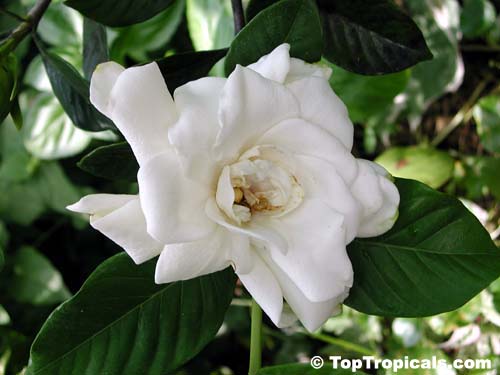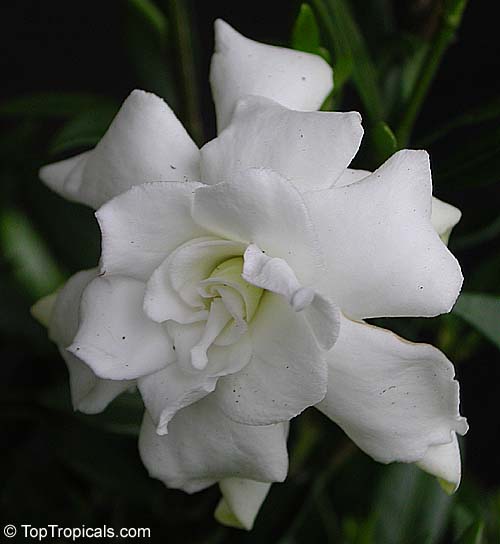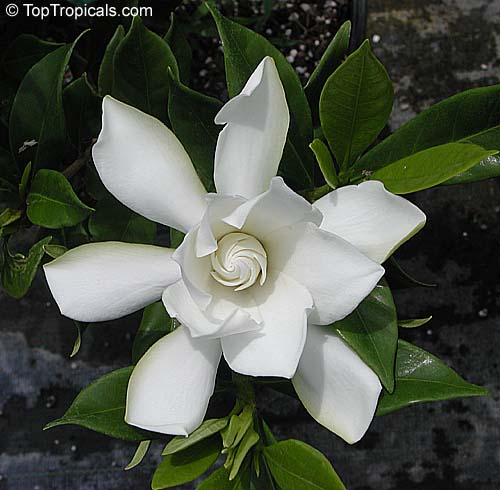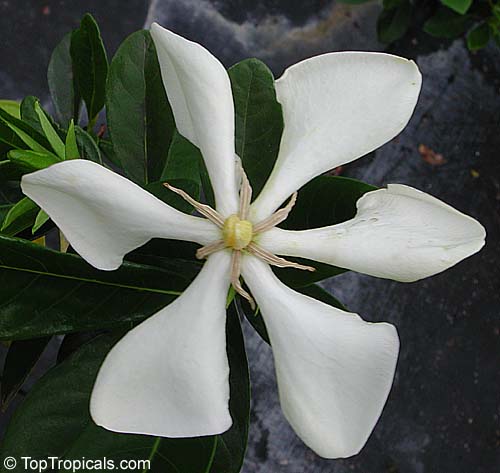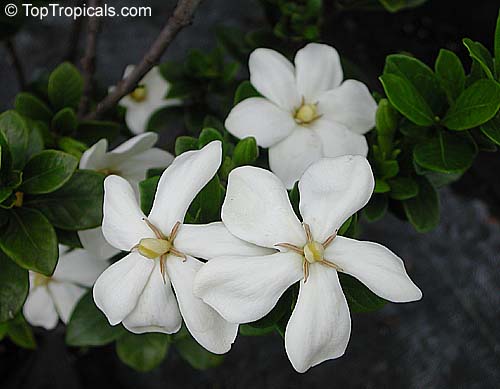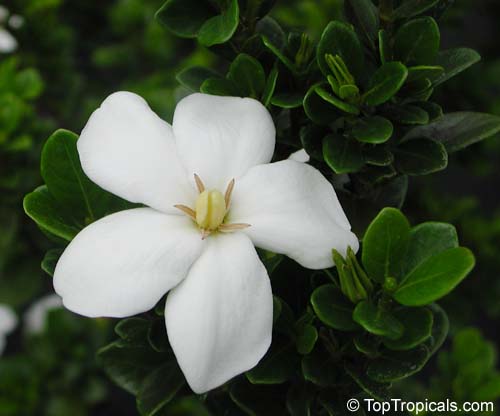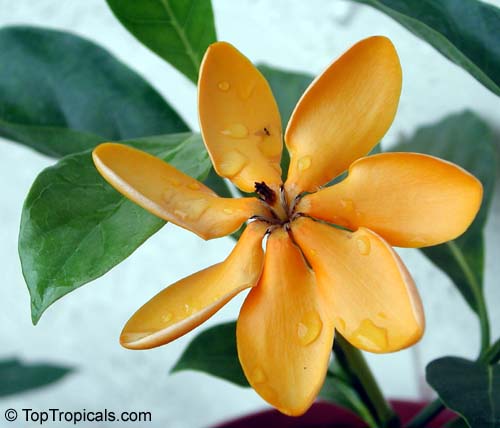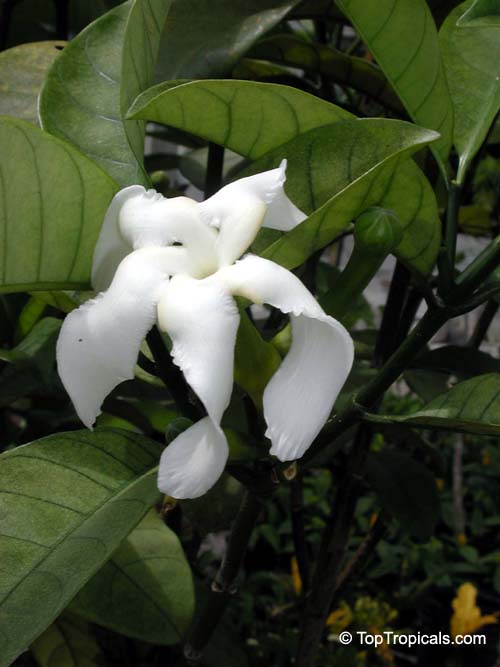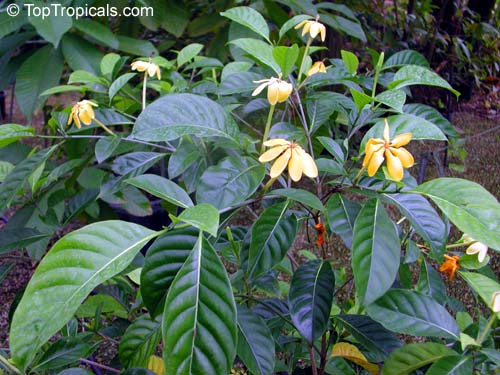Gardenia - Queen of Fragrance
To buy gardenias online click here.
 VIDEO -Gardenia - Queen of Fragrance
VIDEO -Gardenia - Queen of Fragrance
Gardenias are one of our finest shrubs, growing to a height of about six feet in warmer areas of the United States. They have very attractive, shiny evergreen leaves that are about four inches long and, each spring, produce the loveliest of white flowers that are delightfully scented.
The natural range of gardenias is limited by their tropical heritage. Fortunately, they lend themselves to container culture and, by providing winter protection, may be enjoyed for years in the most severe climates.
In-ground planting should only be done In USDA hardiness zones 9 and 10 unless special winter protection is provided.
Planting instructions
Planting mix: When planting in the ground, we recommend a mix composed of:
1/3 coarse sand
1/3 sphagnum peat
1/3 dehydrated cow manure (use it ONLY if you plant
gardenia in the ground. Never use manure in pots)
The sand should be a clean, coarse sand. Builder's sand will do well. The peat
should be fibrous and weed free. Most Canadian peat is fine. The cow manure should
be dehydrated and not composted manure. Dehydrated manure usually carries the
numbers 2-1-2.
Mix well, enough material for your planting job. If the materials are mixed dry, they may be stored without detriment.
Planting in the Ground
Dig your hole two times the diameter of the container that the plant is in.
It should be as deep as the container.
Remove plant from container, being careful not to disturb the roots or root ball.
The roots should not be disturbed even if root bound.
Place plant in hole, making sure soil level of plant is even with or slightly
above ground level. Adjust plant so it is straight and properly faced.
Fill around the plant with planting mix described above until hole is half full.
Fill the hole with water and allow this to settle. Then finish filling the hole
with mix.
The surplus soil removed from the planting can be used to build a dam two to three
inches high around the outside edge of the hole. This should form a saucer which
should be filled with water.
Twice a week for the first six weeks, fill the saucer with water.
The extra soil can then be removed and mulch placed around the plant.
Replanting in Containers
Gardenias can be grown in containers for years. They can be allowed to become fairly rootbound before repotting, but it will be necessary to replant in larger containers every few years.
The same mix described above should be used for repotting. Select a container that is somewhat larger than the current pot. Add enough mix in the bottom of the container to bring the plant to the correct level when it is placed. Remove the gardenia from its present pot carefully without disturbing the roots. Place it in the new container and fill around the sides, working the soil mix in as you go so there are no holes or voids. Water thoroughly, then allow to settle, then rewater.
Watering
After they have become established, gardenias planted in the ground should be watered thoroughly once per week when rain does not provide sufficient water. Local conditions, temperature, wind, and the type of soil may require modification.
In containers, the watering frequency is going to be related to the size of the container, the size of the plant, and conditions where the container is placed. This will probably vary between twice per week and once every other week.
Gardenias will require more water when actively growing than in the winter. Containers should never be allowed to become completely dry. At the same time, more plants in containers are killed by overwatering than by not enough water.
Light
Gardenias bloom best in full sun or light shade.. However, they will grow well
in fairly heavy shade. Plants grown in containers should be placed in well-lighted
locations when indoors. An east window is excellent.
Top of Page
Fertilization
Gardenias are heavy feeders and need to be fertilized on a regular basis. Plants in the ground should be fertilized in January, June, and September with an acid-type fertilizer. at least one fertilization should include minor elements. Plants in containers should usually be fertilized more often as less fertilizer can be applied per application.
Pruning
Pruning is sometimes necessary to help shape your plant or to keep it in size. It is important that pruning be done at the proper time or you may reduce blooming. Pruning may be done anytime after blooming has finished through the first week in October. Cut back to just above a leaf or where a leaf had been attached.
Pests
Whitefly, aphids, some scale insects, and spider mites love gardenias and may require control. Inspect your plants regularly and apply control measures when you find any of these pests present. Use a recommended spray and follow the label directions. Do not spray when the temperature is below 40 or above 80. Use a spreader stick with your insecticide. Coverage is important. Spray from the top downward as well as from under the plant upwards. We alternate between the following, using a different insecticide every time we spray: Orthene, Meta-systox-R, and Cygon. If black sooty mold is present, and the temperature will permit, we use malathion and oil.
Nematodes
One of the major limitations of gardenias is their great susceptibility to nematodes, which are worm-like microscopic organisms which attack the roots of plants. Nematodes are so common in our soils that only gardenias that have been grafted on a special root-stock are recommended. If your gardenia was grown by Carroll's, you can be assured that it is grafted.
Cultivars of Gardenia Jasminoides (augusta)
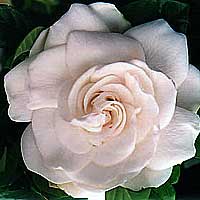
Aimee Yoshioka (sometimes misspelled Aimee Yashioka)
It was developed by Tadaoki Yoshioka while he lived in Hawaii, and he later brought it to Florida when he moved to Ft. Lauderdale with his family in 1954. The gardenia was named after his daughter, Aimee, who died in a plane crash in Dallas in 1984. One of the darkest green of all gardenias, it has a 3 to 5 inch bloom so perfect, it looks artificial. Aimee grows openly and upright and blooms twice a year and slightly later than others.
Leaf Color Excellent
Flower Size 3 - 5"
Flower Season Middle
Flower Shape Large & Perfect
Height 4 - 12'
Flowering Times per Year 2
Growth & Speed Fast
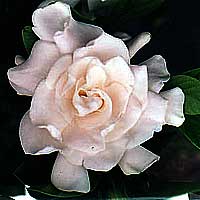
Belmont
The original large bloom, large leaf, very double gardenia. Blooms are 4 to 5 inches in diameter with a good aroma. Leaves are slightly rounded on the end. Belmont probably as the best cold hardiness and least insect problems of the major varieties. It is very hardy!
Leaf Color Excellent
Flower Size 3 - 4"
Flower Season Middle
Flower Shape Large
Height 3 - 12'
Flowering Times per Year 2
Growth & Speed Medium

Coral Gables
Lovely blooms 4 to 5 inches across with a full center. Produces many blooms and is and extremely good grower. This plant is a little more touchy to cold weather than most. Flowers have a nice scent.
Leaf Color Good
Flower Size 3 - 5"
Flower Season Middle
Flower Shape Thick
Height 4 - 15'
Flowering Times per Year 2
Growth & Speed Fast
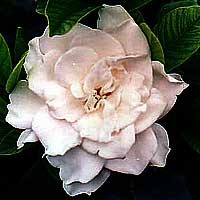
Glazerii
A florist's delight, as the bloom is ideal for corsage work. The flower tends to be flat and some 3 to 5 inches in diameter. The plant is a good, naturally compact grower. Leaves have a slight curl to one side, which is somewhat different from other varieties.
Leaf Color Good
Flower Size 3 - 4"
Flower Season Early
Flower Shape Large & Corsage
Height 3-12'
Flowering Times per Year 2
Growth & Speed Medium
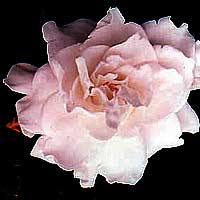
Mary Ann
Mary Ann has all the characteristics of the Aimee with dark green foliage and 3 to 5 inch blooms. It grows openly and has a slightly rounded leaf. The blooms come later after all the other varieties have bloomed. This plant is great to keep as the color and fragrance extend another 4 to 6 weeks.
Leaf Color Excellent
Flower Size 3 - 4"
Flower Season Late
Flower Shape Large & Thick
Height 4 - 12'
Flowering Times per Year 2
Growth & Speed Fast
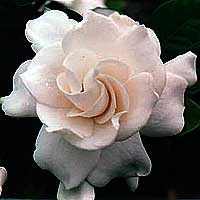
Miami Supreme
One of the most desired plants. It is a good grower with large leaves. Very large flowers, 3 to 5 inches in diameter, March thru June. Has a tendency to have yellow-green foliage.
Leaf Color Fair
Flower Size 3 - 5"
Flower Season Early
Flower Shape Thick
Height 4 - 15'
Flowering Times per Year 2
Growth & Speed Fast
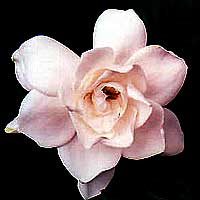
Mystery
One of the older favorites of many people as it is hardier and keeps a larger, darker green foliage. It is a very hardy plant. The flowers are extremely large, reaching about 5 to 6 inches in diameter. They are a flat bloom like the Mary Ann and will bloom about twice a year as they as very rabid growers.
Leaf Color Excellent
Flower Size 3 - 4"
Flower Season Late
Flower Shape Large, wide, open
Height 4 - 12'
Flowering Times per Year 2
Growth & Speed Fast
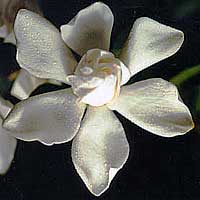
Radicans
With very small leaves, the plant is a compact grower. The blooms are 1 to 2 inches in diameter. The latest of all varieties to bloom, the bloom period continuing into the summer. Outstanding variety for bonsai.
Leaf Color Excellent
Flower Size 1"
Flower Season Late
Flower Shape Small & Perfect
Height 2'
Flowering Times per Year 1
Growth & Speed Slow
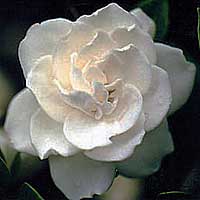
Veitchii
This is a smaller, compact plant with small flowers which have a yellowish center. It blooms two to three times a year. Used as a pot plant as blooms can be forced.
Leaf Color Good
Flower Size 2 - 3"
Flower Season Early
Flower Shape Medium Perfect
Height 3 - 12'
Flowering Times per Year 2 - 4
Growth & Speed Slow
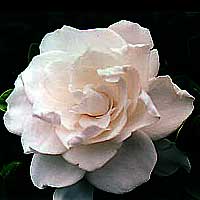
Veitchii Supreme
Has the good features of Veitchii plus a wider leaf and all leaves are very close together, making this a very compact grower. The blooms are extremely large and full in the middle.
Leaf Color Excellent
Flower Size 3 - 5 1/2"
Flower Season Middle
Flower Shape Large & Thick
Height 3 - 10'
Flowering Times per Year 2
Growth & Speed Slow & Compact
Information provided by Carroll Brothers Nursery
